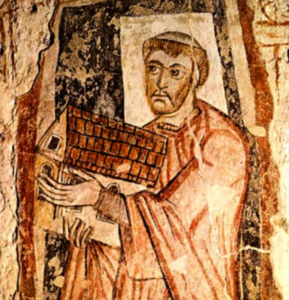
Prof. Plinio Corrêa de Oliveira comments on the life of Saint Benedict Biscop and the lessons that it holds for today. This is the short biography presented to him:
Saint Benedict Biscop (pronounced “bishop”)was born in 621 to a noble Christian family in Northumberland. Educated at the Court of the King Oswy of England, he joined the army and distinguished himself particularly in the handling of arms. King Oswy chose him as his official assistant, and Benedict played a prominent part in the monarch’s military campaigns. Although he received gifts and proofs of esteem because of his valor in combat and fidelity to the king, Benedict took leave from military life and entered religious life. After a pilgrimage to Rome, he returned to England and dedicated himself to studying and praying for several years.
He later joined the Order of Saint Benedict, founded numerous monasteries and raised monastic fervor in those houses where fidelity to the rule had waned. He was a great help to Saint Theodore and Saint Adrian in their activities in England. Saint Benedict Biscop introduced stained glass and paintings to churches on the English isle, as well as sacred music and singing. He sent for architects and artists from Italy to build and adorn the temples. He wrote a book to regularize religious feasts titled On the Celebration of Feasts. Saint Benedict died in 690, stricken with a painful paralysis that cruelly put his patience to the test.
Considering the figure of Saint Benedict Biscop during the period of his life as a religious, we note his special mission. He was a religious man who belonged to the era of the saints who founded nations. Those saints were replaced or succeeded by saints who organized nations.
However, Saint Benedict Biscop was evidently different in that he was a saint who adorned a nation. He developed artistic expressions of religious life in England. He sent for artists with true Catholic inspiration to come from Italy. He ordered stained glass windows and music. The saint established order in religious festivals, which were the only feasts known at the time.
He did all these things that England as a whole. By introducing elements of beauty into religious life, they later spread to civilian life. In all the great cultural movements in the history of Christendom, things started in the religious life and spread to the civilian sphere. Thus, he can be rightly called the adorner of the England of his time.
However, this adorning bishop was not one to employ soft, foolish, or futile adornments. Two great elements of inspiration are found in every true adornment. First of all, it must be conducive to meditation, reflection and profundity since it is directed to those who lead a contemplative life. Thus, this art must be designed with great depth of thought. It must have great beauty and a wealth of content and expression. It must not only pleases the eyes and ears but speak to the mind.
Help Remove Jesus Bath Mat on Amazon
The second element of true adornment is reminiscent of old warriors. Those who engage in this art must be strong, enterprising men who know how to fight. They must have initiative.
Such strong men have always presided over the dawn and rise of art. Soft men, men in rags or men horrified by fighting are the ones who produce decadence in art. At the origin of every true artistic resurgence, we find saints who profoundly meditate, contemplate and know how to be warriors.
[like url=https://www.facebook.com/ReturnToOrder.org]
We can draw these lessons from the life of Saint Benedict Biscop.


